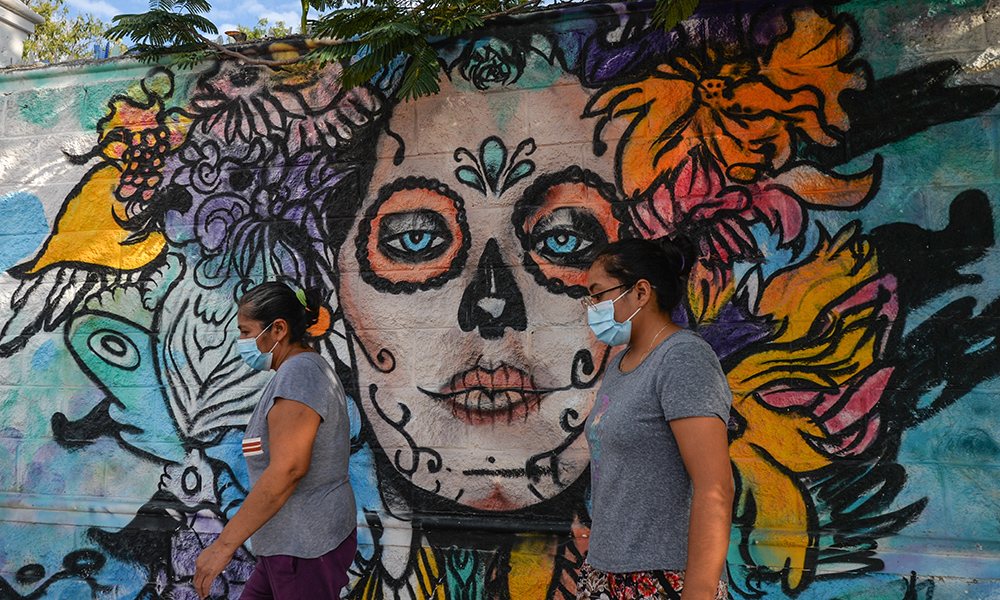研究发现,死亡数周后的新冠患者的遗体仍能传播病毒

新冠患者死亡并不意味着患者体内的病毒也随之消亡。
日本研究人员最近的一项研究,在去世13天的新冠患者遗体内,发现了“大量”具有传染性的病毒。该项研究尚未经过同行审议。与此同时,2021年3月德国的一项研究也得出了类似结论——新冠病毒可能在遗体内存活长达17天。
众所周知,病毒可以在表面长期存活并依旧具有传染力。美国疾病预防控制中心(U.S. Centers for Disease Control and Prevention)表示,有多项研究已经发现,引发新冠肺炎的SARS-CoV-2病毒能够在不锈钢、塑料和玻璃等表面存活长达三天。
自疫情爆发以来,太平间的工作人员就被警告在处理新冠患者遗体时需要小心谨慎,并全程配戴防护装备。对于参加葬礼的人们来说,感染新冠病毒最大的风险来自其他感染者而不是逝者。
疾控中心在4月表示:“在葬礼或探访仪式上,与新冠患者共处一室,目前还没有已知的关联风险。然而,身处在人员密集或通风不佳的空间内,如果周围有人感染,你感染的可能性就会更高。”
世界卫生组织(World Health Organization)表示,埃博拉病毒已知会在葬礼上传播,当家族成员和其他人在宗教仪式上触碰或清洗遗体时,或者发放死者私人物品时,都会传播病毒。这是因为遗体和物品仍携带有病毒。
死于新冠的人不止在呼吸道中藏有病毒。本周在《自然》(Nature)杂志上发表的一片论文发现,在44位去世时感染新冠(但不一定死于新冠)的未接种疫苗的患者体内,在84个人体解剖部位和体液中发现了SARS-CoV-2。这些位置包括大脑、血浆、心脏、淋巴结、肾上腺和眼睛。
研究发现,其中一位患有新冠的患者在症状发作230天后去世,在解剖时依旧在其人体的多个部分发现了病毒。(财富中文网)
译者:刘进龙
审校:汪皓
新冠患者死亡并不意味着患者体内的病毒也随之消亡。
日本研究人员最近的一项研究,在去世13天的新冠患者遗体内,发现了“大量”具有传染性的病毒。该项研究尚未经过同行审议。与此同时,2021年3月德国的一项研究也得出了类似结论——新冠病毒可能在遗体内存活长达17天。
众所周知,病毒可以在表面长期存活并依旧具有传染力。美国疾病预防控制中心(U.S. Centers for Disease Control and Prevention)表示,有多项研究已经发现,引发新冠肺炎的SARS-CoV-2病毒能够在不锈钢、塑料和玻璃等表面存活长达三天。
自疫情爆发以来,太平间的工作人员就被警告在处理新冠患者遗体时需要小心谨慎,并全程配戴防护装备。对于参加葬礼的人们来说,感染新冠病毒最大的风险来自其他感染者而不是逝者。
疾控中心在4月表示:“在葬礼或探访仪式上,与新冠患者共处一室,目前还没有已知的关联风险。然而,身处在人员密集或通风不佳的空间内,如果周围有人感染,你感染的可能性就会更高。”
世界卫生组织(World Health Organization)表示,埃博拉病毒已知会在葬礼上传播,当家族成员和其他人在宗教仪式上触碰或清洗遗体时,或者发放死者私人物品时,都会传播病毒。这是因为遗体和物品仍携带有病毒。
死于新冠的人不止在呼吸道中藏有病毒。本周在《自然》(Nature)杂志上发表的一片论文发现,在44位去世时感染新冠(但不一定死于新冠)的未接种疫苗的患者体内,在84个人体解剖部位和体液中发现了SARS-CoV-2。这些位置包括大脑、血浆、心脏、淋巴结、肾上腺和眼睛。
研究发现,其中一位患有新冠的患者在症状发作230天后去世,在解剖时依旧在其人体的多个部分发现了病毒。(财富中文网)
译者:刘进龙
审校:汪皓
Just because a COVID patient dies doesn’t mean the virus in their body does.
A recent study by researchers in Japan that has yet to be peer reviewed found that infectious virus was present in “large amounts” in cadavers of COVID victims up to 13 days after death. Meanwhile, a March 2021 study out of Germany came to a similar conclusion—that COVID virus can exist in corpses up to 17 days after death.
It was already known that the virus can remain infectious on surfaces for extended periods of time. Multiple studies have indicated that SARS-CoV-2, the virus that causes COVID, can last up to three days on household surfaces like stainless steel, plastic, and glass, according to the U.S. Centers for Disease Control and Prevention.
Since the beginning of the pandemic, mortuary workers have been advised to handle bodies of COVID casualties with caution, and to wear protective equipment while doing so. For those who merely attend funerals, the greatest risk of catching COVID at them is from other attendees who have the virus—not from a corpse.
“There is currently no known risk associated with being in the same room at a funeral or visitation service with the body of someone who died of COVID-19,” the CDC wrote in April. “However, being in crowded or poorly ventilated indoor spaces may make you more likely to get sick if people around you are infected.”
Ebola is known to spread at funerals, during which family members and others touch or wash a cadaver during religious rights, or distribute the deceased’s personal property, according to the World Health Organization. That’s because the body and items continue to carry the virus.
It’s not just the airways of COVID casualties that can harbor the virus. A study published this week in the journal Nature found SARS-CoV-2 in 84 distinct anatomical body locations and fluids in the bodies of 44 unvaccinated individuals who had died with COVID-19 (though not necessarily of it). Those locations included the brain, plasma, the heart, lymph nodes, adrenal gland, and eyes.
In one case, a patient who died with COVID 230 days following the onset of symptoms still had the virus in multiple locations in their body upon autopsy, according to the study.













